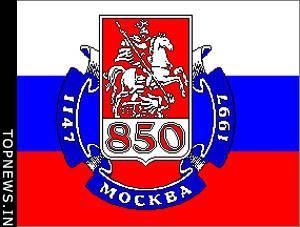Moscow looks remarkably familiar - but mind your p's and h's
 Moscow - The letter "f" looks like an upright line with two ears, "h" stands for "n" and "p" for a rolled "r". Visitors to Moscow have to get to grips with the basics of the Cyrillic alphabet, if they want to make the most of their stay.
Moscow - The letter "f" looks like an upright line with two ears, "h" stands for "n" and "p" for a rolled "r". Visitors to Moscow have to get to grips with the basics of the Cyrillic alphabet, if they want to make the most of their stay.
It may sound daunting, but it is a modest hurdle to take and most visitors should encounter few difficulties in the Russian capital, a city which has a very familiar feel to it, especially to western Europeans.
Inscrutable restaurant menus and bureaucratic quirkiness aside, all you need to enjoy one this fascinating city is a sound guidebook and a reliable map.
One of the first things which strikes visitors are the many elegantly-dressed women dashing around the pavements and squares in amazingly high-heeled stiletto shoes. And then there are the wide boulevards. Chasms might be a better way to describe these mighty thoroughfares which nonetheless divide up the city into manageable chunks.
Take Tverskaya Street, probably one of the best-known radial highways in Moscow. The original low-rise buildings which lined this road were torn down in the 1930s to be replaced with bombastic blocks and offices in the Stalinist style - and also to provide more space for motor traffic.
Main roads like these help tourists to get their bearings but these mighty eight or even 10-lane highways are not easy to get across. It is best to take the first pedestrian underpass which comes into sight - there might not be another for some time to come. Simply crossing the road above ground is not an option in this city of 3 million cars, most of whose drivers seem to regard the roads as race tracks.
Moscow is laid out with ring roads encircling the city. The inner circle contains the Kremlin and Red Square while the next concentric ring, the so-called boulevard ring, takes visitors to important sights such as the Pushkin Art Museum or the Cathedral of Christ the Saviour. Within this area alone, there is enough to keep a visitor occupied for a good week.
Red Square offers typical Moscow sights: Groups of tourists gather around guides holding flags aloft and white stretch-limousines regularly loom into view, halting briefly in front of St Basil's cathedral to allow newlywed Muscovite couples to be photographed on the steps.
The extravagant and brightly-coloured domes of St. Basil's give it an almost Oriental look and provide a sharp architectural contrast to the more austere Lenin mausoleum and the luxury GUM department store which has since been turned into a mall of ultra-exclusive shops.
The only way to gain entrance to the Kremlin, which literally means "fortified town" and overlooks the Moskva River to the south and Red Square to the east, is to pay the admission fee and pass through a security control. The procedure here is the same as in many public buildings in Moscow where visitors' bags are x-rayed and papers are requested.
Tourists who wish to tour the armoury with its sumptuous collection of Czarist artefacts, including jewels, Faberge eggs and clothes, should make up their minds now since an extra ticket is needed and coming back later might be a problem. The museums in Moscow are open only four times a week, generally from Fridays to Wednesdays 0900-1630.
The Kremlin is still classed as a seat of government which means that large parts of the ensemble are sealed off to the general public. There is however still plenty to see here, with six buildings, including three cathedrals grouped around the central square and not forgetting, Ivan the Great, bell tower to the north-east which is said to mark the exact centre of Moscow.
One of the most notable buildings here is the Cathedral of the Annunciation with its golden cupolas where the czars were once crowned. The interior is covered in intricate frescoes which lend it a dark and foreboding air - suddenly western Europe seems a long way off after all.
For something completely different, head for Old Arbat Street, a pedestrian zone which ranks among the city's most popular attractions. There are plenty of souvenir shops alongside the familiar European chain stores. Young men and women stroll along the street hand-in-hand or sip coffee at the many cafes. Along with the ubiquitous Starbucks outlets, local franchises such as "Kofe" house are well-established here and instead of tea from a samovar, the menu offers Latte Macchiato or Greek salad dishes.
Moscow's underground railway is another masterpiece. Steeply-inclined escalators lead down to a subterranean world of "people's palaces", renowned for their ornate and elegant design.
Most were built during Stalin's rule and intended to showcase the best of Soviet architecture. The builders had no qualms either about making lavish use of marble, some of it taken from demolished churches.
With their sumptuous sculptured ceilings, chandeliers and mosaics, these subway stops are a far cry from the claustrophobic stations which characterise the rapid transit systems of other European capitals such as London and Paris.
The subway exemplifies the over-dimensional building style often found in Moscow. The city is dotted with huge monuments and the skyscraper complex, known in English as the "seven sisters", and is a classic example of the pseudo classical "wedding cake style" favoured by Stalin. Erected in the 1940s and '50s, this complex was expressly designed for the glorification of the Soviet state.
Nowadays, the buildings house Moscow State University along with the Ministry of State Affairs and several hotels. (dpa)